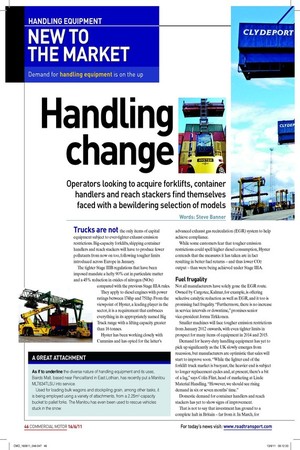Handling change
Page 41

Page 42

If you've noticed an error in this article please click here to report it so we can fix it.
Operators looking to acquire forklifts, container handlers and reach stackers find themselves faced with a bewildering selection of models
Words: Steve Banner Trucks are not the only items of capital equipment subject to ever-tighter exhaust emission restrictions. Big-capacity forklifts, shipping container handlers and reach stackers will have to produce fewer pollutants from now on too, following tougher limits introduced across Europe in January.
The tighter Stage IIIB regulations that have been imposed mandate a hefty 90% cut in particulate matter and a 45% reduction in oxides of nitrogen (NOx) compared with the previous Stage IIIA rules.
They apply to diesel engines with power ratings between 174hp and 751hp. From the viewpoint of Hyster, a leading player in the sector, it is a requirement that embraces everything in its appropriately named Big Truck range with a lifting capacity greater than 16 tonnes.
Hyster has been working closely with Cummins and has opted for the latter’s advanced exhaust gas recirculation (EGR) system to help achieve compliance.
While some customers fear that tougher emission restrictions could spell higher diesel consumption, Hyster contends that the measures it has taken are in fact resulting in better fuel returns – and thus lower CO2 output – than were being achieved under Stage IIIA.
Fuel frugality
Not all manufacturers have solely gone the EGR route. Owned by Cargotec, Kalmar, for example, is offering selective catalytic reduction as well as EGR, and it too is promising fuel frugality. “Furthermore, there is no increase in service intervals or downtime,” promises senior vice-president Jorma Tirkkonen.
Smaller machines will face tougher emission restrictions from January 2012 onwards, with even tighter limits in prospect for many items of equipment in 2014 and 2015.
Demand for heavy-duty handling equipment has yet to pick up signiicantly as the UK slowly emerges from recession, but manufacturers are optimistic that sales will start to improve soon. “While the lighter end of the forklift truck market is buoyant, the heavier end is subject to longer replacement cycles and, at present, there’s a bit of a lag,” says Colin Flint, head of marketing at Linde Material Handling. “However, we should see rising demand in six or seven months’ time.” Domestic demand for container handlers and reach stackers has yet to show signs of improvement.
That is not to say that investment has ground to a complete halt in Britain – far from it. In March, for example, Barloworld Handling, Hyster’s sole distributor in the UK, announced it had received a multi-millionpound order from intermodal freight specialist Freightliner to supply 32 pieces of container-handling equipment to its sites nationwide.
The order includes Hyster reach stackers, Hyster empty-container handlers and Terberg terminal tractors.
Barloworld is supporting them with a planned maintenance programme and round-the-clock service response. It employs 500 engineers across the country.
“It is rare to have spare container-handling equipment to fall back on in port and terminal operations, which is why Barloworld is committed to a 98% uptime benchmark for the Freightliner leet,” says Barloworld MD Phil Bastow.
Smaller orders for machinery can be gratifying too. Last October, Clydeport took delivery of a Hyster emptycontainer handler for its Greenock ocean terminal, again through Barloworld. Operating 70-plus hours a week, it stacks containers ive-high, and can go higher if required.
Spoilt for choice
No matter whether they are acquiring one machine or an entire leet, buyers are being confronted by an almostbewildering variety of new models.
Last year, Kalmar unveiled the DCF70-40E emptycontainer handler, the latest and inal machine to join the company’s F-generation range. It is designed for customers requiring a lifting capacity of up to 7 tonnes, plus the ability to stack empty containers four or ive high.
Cutting maintenance costs is a priority for many buyers, and maintenance intervals have been stretched from 250 to 500 hours. Driver comfort and safety are important considerations too, and the DCF70-40E is itted with Kalmar’s Spirit Delta cab. Separately suspended and isolated, it offers 360° vision.
Addressing another sector of the market, Linde Material Handling launched a range of 10to 18-tonne forklifts in February. Again, the stress is on operator comfort and safety, with productivity – the fuel tank is more than 60% bigger to extend working hours and thus productivity – and ease-of-maintenance counted as important features too.
The cab can be hydraulically tilted to the side allowing better access to the engine and hydrostatic drive for easier servicing. Access to items that need replacing regularly – such as oil, air and fuel ilters – has been made simpler too.
Remote monitoring of equipment and its activities is becoming more important, a trend that is likely to accelerate. One area of pollution that will be addressed more closely is noise. “Remember that many terminals want to operate around the clock, so they need quieter equipment,” observes Bastow.
He also believes that an increasing number of machines will be itted with onboard weighing equipment to allow them to detect how evenly a container is loaded as well as check its gross weight.
As hauliers know to their cost, there can be a signiicant difference between the weight stated by the consignee on the accompanying paperwork and the box’s true tonnage. And it is the driver and the haulier who have to face the music if the former is stopped in a roadside check and the truck is overloaded. ■














































